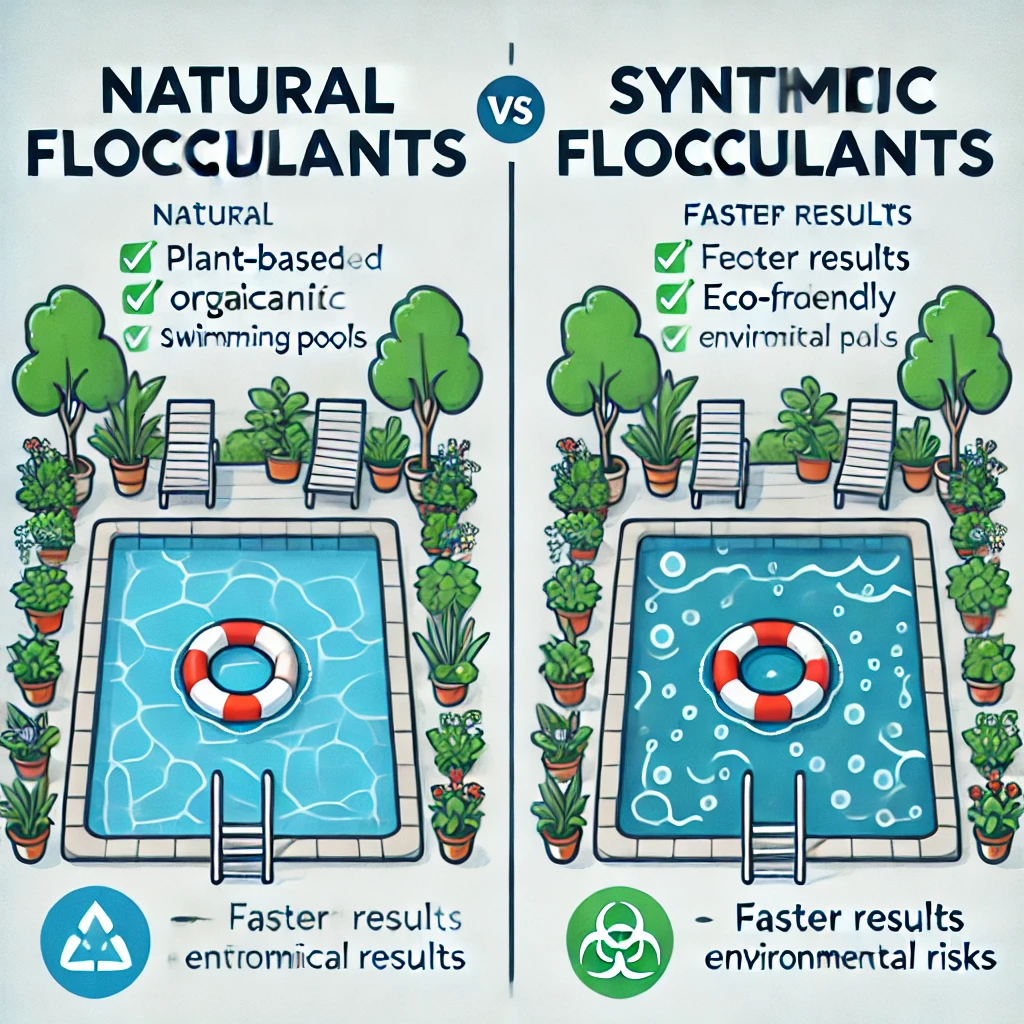Flocculants play a crucial role in water treatment. They help in the aggregation of suspended particles, leading to cleaner water. The debate between natural and synthetic flocculants has been ongoing. Both have their advantages and disadvantages. But, which is more effective, especially as a pool flocculant? This article delves into this question.

I. Understanding Flocculants
Flocculants are substances that promote the clumping of particles in liquids. These particles then settle at the bottom, making it easier to remove them. In pools, flocculants help maintain clear water by removing contaminants. The choice between natural and synthetic flocculants depends on various factors. These include cost, efficiency, and environmental impact.
How Do Flocculants Work?
Flocculants neutralize the charges of suspended particles in water. This neutralization leads to the aggregation of particles into larger clumps. These clumps, or flocs, then settle at the bottom, making removal easier. The effectiveness of a flocculant depends on its chemical composition and the water’s characteristics.
II. What Are Natural Flocculants?
Natural flocculants are derived from organic materials. These include plants, animals, and microorganisms. Common examples are starch, chitosan, and guar gum. They are biodegradable and environmentally friendly. Moreover, they produce less sludge compared to synthetic flocculants. However, they may be less effective in some cases. Their efficiency can vary depending on the type of water being treated.
Benefits of Natural Flocculants
Natural flocculants offer several benefits, particularly in environmental sustainability. They break down naturally, minimizing ecological harm. Additionally, they often require less processing and produce fewer byproducts. This makes them an attractive option for eco-conscious operations.
III. What Are Synthetic Flocculants?
Synthetic flocculants, on the other hand, are man-made chemicals. They are often more effective at lower dosages. Polyacrylamide is a widely used synthetic flocculant. It is highly efficient and can treat a wide range of water types. However, synthetic flocculants are not biodegradable. They may pose environmental risks if not managed properly. They can also produce more sludge, which requires further treatment.
Advantages of Synthetic Flocculants
The primary advantage of synthetic flocculants is their efficiency. They act quickly and require smaller quantities to achieve the desired results. This makes them cost-effective for large-scale applications. Additionally, they are versatile and can be tailored to different water treatment needs.
IV. Comparing Efficiency
When comparing natural and synthetic flocculants, efficiency is a key factor. Synthetic flocculants generally act faster and more effectively. They require lower dosages, making them cost-effective for large-scale operations. However, natural flocculants can be equally effective in specific situations. For instance, they work well in treating water with high organic content. Additionally, natural flocculants are preferred in eco-friendly operations. They offer a greener alternative, reducing the environmental footprint.
Factors Influencing Efficiency
Several factors influence the efficiency of flocculants. These include water temperature, pH levels, and the concentration of suspended particles. Synthetic flocculants often perform better across a wider range of conditions. In contrast, natural flocculants may require more specific conditions to be effective.
V. Environmental Impact
Environmental impact is a significant consideration. Natural flocculants are biodegradable, making them less harmful to ecosystems. They decompose naturally, leaving no toxic residues. In contrast, synthetic flocculants can persist in the environment. They may accumulate in water bodies, potentially harming aquatic life. Therefore, the long-term environmental costs of synthetic flocculants can be substantial.
Long-Term Environmental Considerations
The long-term use of synthetic flocculants can lead to accumulation in water systems. This accumulation may disrupt aquatic ecosystems and water quality. On the other hand, natural flocculants degrade naturally, posing fewer long-term risks.
VI. Cost Considerations
Cost is another important factor. Synthetic flocculants are generally cheaper in the short term. Their lower dosage requirements and rapid action reduce operational costs. However, the environmental costs associated with their use can be high. Natural flocculants might be more expensive initially. But, they can offer long-term savings by reducing environmental damage. Therefore, the choice between the two often comes down to balancing immediate costs with long-term sustainability.
Balancing Costs and Benefits
When evaluating cost, it’s essential to consider both immediate and long-term expenses. While synthetic flocculants may save money upfront, natural flocculants can provide savings over time by reducing environmental remediation costs.

VII. Pool Flocculants: Which Is Better?
For pool flocculants, the decision is context-dependent. Synthetic flocculants may offer quicker results, especially in heavily contaminated pools. They are also more reliable for consistent performance. However, natural flocculants are safer for the environment. They are ideal for pools where environmental impact is a concern. Moreover, natural flocculants can be gentler on pool equipment and surfaces.
Choosing the Right Pool Flocculant
The right pool flocculant depends on the specific needs of the pool. Consider factors such as water quality, environmental impact, and maintenance costs when making a decision.
